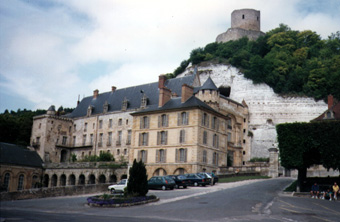History

|
9th Century castle on hill,
11th Century structure built into the hill
and 16th Century castle in foreground.
|
Normandy was named from the Scandinavian men, Norsemen, who invaded in AD 820.
There were many turbulent times in this province's history.
The early Celts arrived in the region in the 5th century BC. Their descendants currently remain in neighboring Brittany. The Romans then invaded and conquered Normandy , building where Evreux, Rouen, and Coutances now stand.
Even Lillebonne has
evidence of their presence in ruins. When raided by the Saxons and Germans toward the end of the 4th century, the Romans left,
leaving Normandy a battleground between the warring groups. From 500 AD to the 9th century, the area was
under Frankish domination, and the influence is seen in the region's cathedrals. The Norsemen sometimes destroyed many of the religious establishments and by the early 10th century the invaders had settled. In 911 the Norman leader,
Rolf the Ranger, became Rollo, Duke of Normandy. Rolf's most famous descendent was William the Bastard, who successfully invaded England in 1066. Thereafter he was known as William the Conqueror. Over the next 138 years Normandy's potential as a threat
to the French throne dominated its history.
This became a problem after the English King Henry II added to his empire the territories of Aquitaine by marriage to the Duchess Eleanor.

|
Cathedral in Caen
|
Henry's son Richard built the Chateau Gaillard on the Seine close to the
borders of the French territories. However,
his brother, John Lackland, lost Normandy in 1202 , when Philippe Auguste invaded the duchy to avenge John's murder of his nephew, Arthur of Brittany.
After 1204 Normandy was under French rule,
first as a duchy and later as a province with its own
governing body at Rouen. Battles continued between French and English kings, especially during the Hundred Years' War, which ended in 1453.
For the next hundred years, Normandy enjoyed peace and prosperity, with the construction of great castles like Chateaux d'O and Fontaine-Henry.
Rouen and Caen became free cities; also the wealthy merchant classes built the half-timbered houses that still line the old streets of Rouen.

|
Omaha Beach
|
Things remained relatively calm in Normandy until 1944, when World War II battles to liberate France from the Nazis occurred. Hundreds and thousands of buildings,
and about 600 towns and villages, were destroyed. Le Havre, St-Lo, Caen, Lisieux,
and Evreux were almost completely destroyed. Bayeux with its magnificent cathedral tapestries remained virtually intact.
The urban face of Normandy changed dramatically;
however, the rural green pasturelands remain almost unchanged.
- Linda Wagner
- 16995 Kennedy Rd.
- Los Gatos, CA. 95032
wagnerlinda@hotmail.com







